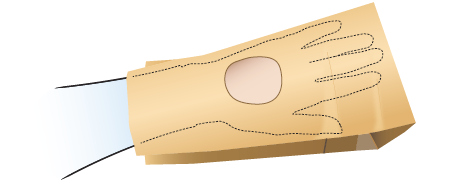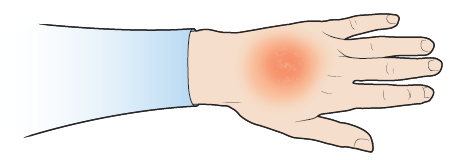This information explains what PDT is. It also explains what to expect before, during, and after PDT to treat esophageal (ee-SAH-fuh-JEE-ul) or lung cancer.
About PDT
PDT is a cancer treatment. It uses a photosensitizing (FOH-toh-SEN-sih-ty-zing) agent and a special type of light to kill cancer cells. A photosensitizing agent is medicine that makes cells very sensitive to light. For your PDT treatment, you will get the photosensitizing agent Photofrin® (porfimer sodium).
PDT treatment has 2 steps.
- First, a nurse will slowly inject (put) the Photofrin into your bloodstream. This is called an intravenous (IV) injection. The cancer cells will absorb (take in) the Photofrin.
- Then 2 to 3 days later, you will have a bronchoscopy (bron-KOS-koh-pee) or endoscopy (en-DOS-koh-pee). The procedure you have depends on the cancer’s location. During your procedure, your healthcare provider will shine a special laser light on the area where the cancer is. The laser light will activate (turn on) the photosensitizing agent. This causes a chemical reaction that kills the cancer cells.
If you’re having a bronchoscopy: After your first bronchoscopy, you will have a second bronchoscopy 2 to 3 days later. This procedure is to take out any cancer cells that remain.
If you’re having an endoscopy: You will have another PDT treatment 2 days after your endoscopy.
Your healthcare provider will talk with you about what to expect. To learn more, read the “About your bronchoscopy or endoscopy” section.
Getting ready for your PDT
Tell your care team about your medicines
Tell your care team about all the medicines you’re taking. This includes prescription and over-the-counter medicines, dietary supplements, patches, and creams. Some medicines can make your skin more sensitive to light. This is called photosensitivity (FOH-toh-SEN-sih-TIH-vih-tee). If any of your medicines increase your photosensitivity, you may need to stop taking them before your PDT treatment.
Plan to avoid bright light
Starting right after your Photofrin injection, you will be photosensitive (sensitive to light). The photosensitivity can last for 4 to 6 weeks or longer. During this time, you must avoid bright light, including sunlight.
Your healthcare provider will talk with you about what to do while you’re photosensitive. They will also give you a photosensitivity safety kit. The kit includes:
- A wide-brimmed hat with a flap to cover your neck
- Sunglasses
- Elbow-length gloves
- A wallet card that says you had PDT
To learn more about protecting yourself while you’re photosensitive, read the “How to manage photosensitivity” section.
About your IV Photofrin injection
You will get your IV Photofrin injection during an outpatient clinic appointment.
On the day of your appointment, wear a shirt with long sleeves, long pants, socks, and shoes. Choose clothing that’s opaque (you can’t see through it). You can check if clothing is opaque by holding it up to a light. If you can see the light through the clothing, it’s not fully opaque. You should also bring an opaque scarf and the items from your photosensitivity safety kit.
During your appointment, a nurse will place an IV line (thin, flexible tube) into a vein in your arm or hand. Then, they will inject the Photofrin into your bloodstream for about 10 minutes. You should not feel any pain or discomfort during the injection. If you do, tell your nurse.
You can leave the clinic right after your injection. Remember that you will be photosensitive. Follow the guidelines in the “How to manage photosensitivity” section.
About your bronchoscopy or endoscopy
Your bronchoscopy or endoscopy will be 2 to 3 days after your Photofrin injection. It will be done at Memorial Sloan Kettering Cancer Center (MSK).
What to expect if you’re having a bronchoscopy
If you’re having a bronchoscopy, your nurse will give you the resource About Your Flexible Bronchoscopy. Read this resource to learn more about how to get ready and what to expect during your procedure.
You may need to stay in the hospital overnight after 1 or both of your bronchoscopies. This is so your care team can make sure you recover safely. Your healthcare provider will decide if you need to stay overnight based on what they see during your procedure.
What to expect if you’re having an endoscopy
If you’re having an endoscopy, your nurse will give you the resource About Your Upper Endoscopy. Read this resource to learn more about how to get ready and what to expect during your procedure.
You can leave the hospital after your endoscopy. You will need a second PDT treatment 2 days later.
Where to go
Your bronchoscopy or endoscopy will be done at:
Endoscopy suite at Memorial Hospital (the main hospital at MSK)
1275 York Ave. (between East 67th and East 68th streets)
New York, NY 10065
Take the B elevator to the 2nd floor. Turn right and enter the Surgery and Procedural Center through the glass doors.
Follow-up appointment
Your doctor’s office will call you to schedule a follow-up appointment after your bronchoscopy or endoscopy.
How to manage photosensitivity
You will be most photosensitive during the first 3 to 7 days after your Photofrin injection. Your photosensitivity will slowly decrease as you’re exposed to ambient light over time. An example of ambient light is the light from a lamp with a lampshade. Ambient light breaks down the Photofrin in your skin.
Follow these photosensitivity precautions (safety measures) for at least the first 30 days after your Photofrin injection.
-
Do not expose your skin or eyes to bright light. Examples of bright light are:
- Direct sunlight.
- Skylights.
- Light bulbs without a lampshade.
- Halogen lights and spotlights.
- Exam lights (such as those used by a dentist or eye doctor).
- Tell your PDT healthcare provider before you see any other healthcare providers while you’re photosensitive. Your PDT healthcare provider will talk with them about what they need to do to keep you safe.
-
Wear these protective clothing and sunglasses every time you leave your home. Wear them even on cloudy days, at nighttime, and while riding in cars. You must wear:
- A shirt with long sleeves, long pants, a scarf, shoes, and socks. Choose clothing that’s opaque (you can’t see through it).
- The sunglasses, wide-brimmed hat, and elbow-length gloves from your photosensitivity safety kit.
- Carry the PDT wallet card with you. If you need medical care while you’re photosensitive, show the card to the healthcare provider.
- Group your errands together. Do them at night, if you can. Remember to wear protective clothing and sunglasses.
- You do not need to wear sunscreen. Sunscreen does not protect your skin from photosensitivity.
- It’s OK to expose your skin to light from electronics (such as a TV, cell phone, or computer). Try not to be too close to large screens. If you’re close to a large screen, turn down the screen’s brightness, if you can.
- Avoid using heating pads. They can cause your skin to turn red, which can look like a burn.
Make sure you’re getting a safe amount of light by measuring the number of lux you’re exposed to. A lux is a unit used to describe the amount of light in an area. While you’re photosensitive, you should only be exposed to 200 lux of light or less. You can measure lux using an app on your smartphone, such as the Lux Light Meter Pro app.
Do not stay in complete darkness. You can have lights on inside your house, as long as they’re covered with a shade. Starting 30 days after your Photofrin injection, you can also open your curtains on dull, cloudy days. The ambient light in your home will break down the Photofrin in your skin over time.
Paper bag test
Thirty (30) days after your Photofrin injection, do a paper bag test to check your level of photosensitivity. This will help you know if you must keep following photosensitivity precautions.
To do a paper bag test:
- Get a small brown paper bag.
- Cut a small hole in the bag. The hole should be about 2 inches (5 centimeters) across.
-
Put your hand into the bag so the hole is over the back of your hand (see Figure 1).

Figure 1. Put the paper bag over your hand
- With the paper bag over your hand, expose the hole to sunlight for 10 minutes. Keep the rest of your body covered.
-
If you notice a skin reaction, stop exposing the hole to sunlight right away. An example of a skin reaction is redness (see Figure 2) or discomfort.

Figure 2. An example of a skin reaction - If you do not notice a skin reaction, wait for 12 hours, then check the area again. Some people have a delayed reaction.
If you have a skin reaction within 12 hours of the paper bag test, you’re still photosensitive. Keep following the guidelines in the “How to manage photosensitivity” section for 1 week. Then, repeat the paper bag test.
If you do not have a skin reaction, you can slowly start exposing yourself to bright light, including sunlight.
When to call your healthcare provider
Call your healthcare provider if:
- Any area of your skin has swelling, redness, blistering, or all 3. These are signs of a skin burn.
- You have any questions or concerns.